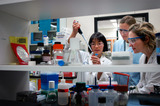
Scientists get some of their best ideas from biology. Whether that be using bacteria to help make food or gene editing to cure disease, biotechnology uses the tools in biology to make amazing technology. This resource is part of the Agricultural Cyberbiosecurity Education Resource Collection that contains resources for formal and non-formal agricultural educators working with middle school aged youth. Published as Open Educational Resources, all resources are provided in durable (pdf) and customizable (MS Word) formats. They are hosted on GoOpenVA in a unique resource collection, Ag Cybersecurity Virginia Tech, at https://goopenva.org/curated-collections/143 and on on Virginia Tech’s stable repository, VTechWorks at https://doi.org/10.21061/cyberbiosecurity
- Subject:
- Agricultural Education
- Business and Information Technology
- Cybersecurity
- STEM/STEAM
- Material Type:
- Reading
- Author:
- Ag Cybersecurity Virginia (VT)
- Date Added:
- 05/01/2023